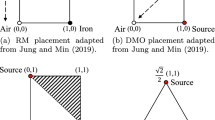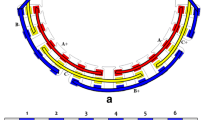Abstract
In this paper, the authors propose a flexible automatic procedure for optimizing multiphase single-layer winding end-connections by the differential evolution algorithm. By using the winding distribution in slots as a predefined input, connections between phase conductors located in different slots are determined to minimize the winding average coil pitch and to simultaneously maximize the number of coils with identical coil pitch. For an adopted geometrical shape and number of turns of individual coils, minimization of winding average coil pitch results in minimized end-connection length, winding resistances, end-leakage inductances, winding mass and copper losses, while machine efficiency and power factor are maximized. However, maximizing the number of identical coils simplifies and speeds up the process of coil fabrication during machine assembly, but potentially leads to higher average coil pitch. The proposed method is applied to single-layer windings with different slot, pole and phase combinations, where it is proven that the method automatically provides end-connection arrangements which are better or equal in terms of copper usage and simplicity of fabrication than the ones found in the literature. Verification is conducted by comparing overall performance of several Rotor Permanent Magnet Flux Switching motors with different stack lengths, outer diameters and optimized end-windings by means of 2D finite element analysis and 3D analytical approach. The proposed method is conceived as an automatic tool for optimization of single-layer winding end-connections during comprehensive electrical machine design optimization.













Similar content being viewed by others
Availability of data and materials
Not applicable.
Code availability
Not applicable.
Abbreviations
- A :
-
Winding distribution table/matrix
- \(a_{n,k}^{( + )}\), \(a_{n,k}^{( - )}\) :
-
Elements of the winding distribution table
- a p :
-
Number of winding parallel paths
- A s :
-
Total slot area
- c :
-
Weighing factor
- c 0 :
-
Critical value of the weighing factor
- C n :
-
Connection matrix for n-th phase
- CR :
-
Differential evolution crossover rate
- DE:
-
Differential evolution
- f(Y n):
-
Objective function
- F :
-
Differential evolution scaling factor
- FEA:
-
Finite element analysis
- G :
-
Number of generations/iterations of the differential evolution algorithm
- i :
-
Population member index
- J :
-
Current density in conductors
- j :
-
Optimization variable index
- k :
-
Coil index
- k Cu :
-
Slot filling factor
- l ew :
-
Average length of a single coil end-connection
- L ew :
-
End-leakage inductance
- L sew :
-
End-winding self-inductance
- m :
-
Number of phases (phase windings)
- m Cu :
-
Copper mass
- M ew :
-
End-winding mutual inductance
- MMF:
-
Magnetomotive force
- n :
-
Phase index
- N c :
-
Number of coils per turn
- n lay :
-
Number of winding layers
- N p :
-
Number of population members in the differential evolution algorithm
- n wc :
-
Number of wound coils per phase
- p :
-
Number of pole pairs
- P Cu :
-
Copper losses
- Q s :
-
Number of slots
- R ew :
-
End-winding resistance
- RPMFS:
-
Rotor Permanent Magnet Flux Switching
- T n :
-
Vector containing all positive elements from n-th row of the winding distribution table
- u :
-
Number of coils with different coil pitch
- U n , i , G :
-
i-th trial vector for n-th phase on G-th generation of the differential evolution algorithm
- V n , i , G :
-
i-th donor vector for n-th phase on G-th generation of the differential evolution algorithm
- WDT:
-
Winding distribution table
- X n , i , G :
-
i-th variable vector for n-th phase on G-th generation of the differential evolution algorithm
- \(x_{k}^{(n)}\) :
-
Element of n-th phase variable vector
- Y n :
-
Coil pitch vector for n-th phase
- \(y_{{{\text{avg}}}}^{(n)}\) :
-
Average coil pitch of n-th phase
- \(y_{k}^{(n)}\) :
-
Coil pitch of k-th coil in n-th phase
- γ Cu :
-
Mass density of copper
- ρ Cu75 :
-
Resistivity of copper at 75 °C
References
Germishuizen JJ, Kremser A (2021) Algebraic design of symmetrical windings for AC machines. IEEE Trans Ind Appl 57(3):1928–1934. https://doi.org/10.1109/TIA.2021.3057607
Caruso M, Tommaso AD, Marignetti F, Miceli R, Galluzzo G (2018) A General mathematical formulation for winding layout arrangement of electrical machines. Energies 11(2):446–470. https://doi.org/10.3390/en11020446
Alteheld C, Hartmann AK, Gottkehaskamp R (2016) A new systematic method to design windings of polyphase rotating electrical machines and evaluation of their optimization potential. In: Proceedings of XXII international conference on electrical machines (ICEM), pp 1257–1263. https://doi.org/10.1109/ICELMACH.2016.7732686
Caruso M, Tommaso AD, Miceli R, Rizzo R (2018) Computer-aided analysis and design procedure for rotating induction machine magnetic circuits and windings. IET Electr Power Appl 12(6):885–893. https://doi.org/10.1049/iet-epa.2017.0310
Tommaso AD, Genduso F, Miceli R (2015) A new software tool for design, optimization, and complete analysis of rotating electrical machines windings. IEEE Trans Magn 51(4):1–10. https://doi.org/10.1109/TMAG.2014.2369860
Alberti L (2018) Koil: a tool to design the winding of rotating electric machinery. In: Proceedings of XIII international conference on electrical machines (ICEM), pp 805–811. https://doi.org/10.1109/ICELMACH.2018.8507004
Ouamara D, Dubas F, Benallal MN, Randi SA, Espanet C (2018) Automatic winding generation using matrix representation—Anfractus tool 1.0. Acta Polytech 58(1):37–46. https://doi.org/10.14311/AP.2018.58.0037
Ferreira FJTE, Silva AM, Almeida AT (2017) Software tool for fast and optimized stator winding design of three—phase induction motors. In: Proceedings of X international conference on energy efficiency in motor driven systems (EEMODS) 2017, pp 370–389. https://doi.org/10.2760/345473
Bianchi N, Bolognani S, Pre MD, Grezzani G (2006) Design considerations for fractional-slot winding configurations of synchronous machines. IEEE Trans Ind Appl 42(4):997–1006. https://doi.org/10.1109/TIA.2006.876070
Germishuizen JJ, Kamper MJ (2010) Classification of symmetrical non-overlapping three-phase windings. In: Proceedings of XIX international conference on electrical machines (ICEM), pp 1–6. https://doi.org/10.1109/ICELMACH.2010.5608096
Bekka N, Zaïm MEH, Bernard N, Trichet D (2016) A novel methodology for optimal design of fractional slot with concentrated windings. IEEE Trans Energy Convers 31(3):1153–1160. https://doi.org/10.1109/TEC.2016.2552546
Kalt S, Erhard J, Lienkamp M (2019) Optimized stator design method using machine parameter permutation. Forsch Ingenieurwes 83:853–861. https://doi.org/10.1007/s10010-019-00385-y
Fornasiero E, Alberti L, Bianchi N, Bolognani S (2013) Considerations on selecting fractional-slot nonoverlapped coil windings. IEEE Trans Ind Appl 49(3):1316–1324. https://doi.org/10.1109/TIA.2013.2251853
Alberti L, Bianchi N (2013) Theory and design of fractional-slot multilayer windings. IEEE Trans Ind Appl 49(2):841–849. https://doi.org/10.1109/ECCE.2011.6064188
Tessarolo A, Ciriani C, Bortolozzi M, Mezzarobba M, Barbini N (2019) Investigation into multi-layer fractional-slot concentrated windings with unconventional slot-pole combinations. IEEE Trans Energy Convers 34(4):1985–1996. https://doi.org/10.1109/TEC.2019.2929950
Silva AM, Ferreira FJTE, Cistelecan MV, Antunes CH (2019) Multiobjective design optimization of generalized multilayer multiphase AC winding. IEEE Trans Energy Convers 34(4):2158–2167. https://doi.org/10.1109/TEC.2019.2935009
Silva AM, Antunes CH, Mendes AMS, Ferreira FJTE (2021) On phase shifting and diversified coil-pitch for enhanced multiobjective winding design optimization. IEEE Trans Energy Convers. https://doi.org/10.1109/TEC.2020.3037358
Das S, Suganthan PN (2011) Differential evolution: a survey of the state-of-the-art. IEEE Trans Evol Comput 15(1):4–31. https://doi.org/10.1109/TEVC.2010.2059031
Gerngroß M, Herrmann P, Endisch C, Westermaier C (2019) Optimization of the end winding patterns in needle wound traction stators. In: Proceedings of IEEE international conference on mechatronics (ICM), pp 314–320. https://doi.org/10.1109/ICMECH.2019.8722897
Silva AM, Ferreira FJTE, Antunes CH (2019) A hybrid multiobjective differential evolution approach to stator winding optimization. In: Kaufmann P, Castillo P (eds) Applications of evolutionary computation. EvoApplications 2019. Lecture notes in computer science, vol 11454. Springer, Cham. https://doi.org/10.1007/978-3-030-16692-2_5
Lampinen J, Zelinka I (1999) Mixed integer-discrete-continuous optimization by differential evolution, Part 1: the optimization method. In: Proceedings of 5th international mendel conference on soft computing (MENDEL'99), pp 71–76
Lampinen J, Zelinka I (1999) Mixed integer-discrete-continuous optimization by differential evolution, Part 2: a practical example. In: Proceedings of 5th international mendel conference on soft computing (MENDEL'99), pp 77–81
Tommaso AD, Genduso F, Miceli R, Galluzzo GR (2016) An exact method for the determination of differential leakage factors in electrical machines with non-symmetrical windings. IEEE Trans Magn 52(9):1–9. https://doi.org/10.1109/TMAG.2016.2562602
Lekić Ð, Vukosavić S (2018) Finite element design of rotor permanent magnet flux switching machine with arbitrary slot, pole and phase combinations. Electronics 22(2):93–104. https://doi.org/10.7251/ELS1822093L/10.7251/911ELS1822093L
Žarko D, Ban D, Klarić R (2005) Finite element approach to calculation of parameters of an interior permanent magnet motor. Automatika J Control Meas Electron Comput Commun 46(3–4):113–122
Ban D, Žarko D, Mandić I (2005) Turbogenerator end-winding leakage inductance calculation using a 3-D analytical approach based on the solution of Neumann Integrals. IEEE Trans Energy Convers 20(1):98–105. https://doi.org/10.1109/TEC.2004.837300
Pyrhönen J, Jokinen T, Hrabevcova V (2008) Design of rotating electrical machines. Wiley, Wiltshire. https://doi.org/10.1002/9781118701591
Funding
Not applicable.
Author information
Authors and Affiliations
Contributions
Đorđe M. Lekić developed the theoretical formalism, performed the analytic calculations and performed the numerical simulations. Both authors discussed the results and contributed to the final version of the manuscript. Slobodan N. Vukosavić supervised the findings of this work.
Corresponding author
Ethics declarations
Conflict of interest
The authors declare that they have no conflict of interest.
Additional information
Publisher's Note
Springer Nature remains neutral with regard to jurisdictional claims in published maps and institutional affiliations.
Rights and permissions
About this article
Cite this article
Lekić, Đ.M., Vukosavić, S.N. Optimization of multiphase single-layer winding end-connections by differential evolution. Electr Eng 104, 2589–2602 (2022). https://doi.org/10.1007/s00202-022-01498-4
Received:
Accepted:
Published:
Issue Date:
DOI: https://doi.org/10.1007/s00202-022-01498-4




